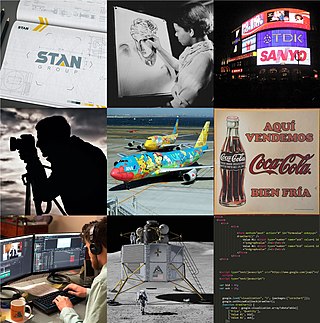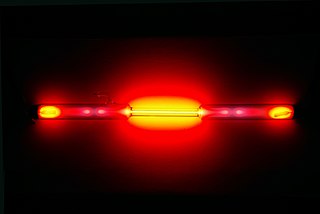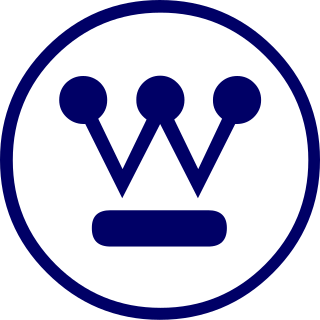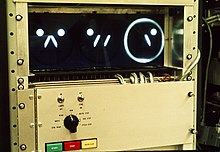
Graphic design is a profession, academic discipline and applied art whose activity consists in projecting visual communications intended to transmit specific messages to social groups, with specific objectives. Graphic design is an interdisciplinary branch of design and of the fine arts. Its practice involves creativity, innovation and lateral thinking using manual or digital tools, where it is usual to use text and graphics to communicate visually.

Neon is a chemical element with the symbol Ne and atomic number 10. It is a noble gas. Neon is a colorless, odorless, inert monatomic gas under standard conditions, with about two-thirds the density of air. It was discovered in 1898 as one of the three residual rare inert elements remaining in dry air, after nitrogen, oxygen, argon and carbon dioxide were removed. Neon was the second of these three rare gases to be discovered and was immediately recognized as a new element from its bright red emission spectrum. The name neon is derived from the Greek word, νέον, neuter singular form of νέος, meaning 'new'. Neon is chemically inert, and no uncharged neon compounds are known. The compounds of neon currently known include ionic molecules, molecules held together by van der Waals forces and clathrates.

Electroluminescence (EL) is an optical and electrical phenomenon, in which a material emits light in response to the passage of an electric current or to a strong electric field. This is distinct from black body light emission resulting from heat (incandescence), a chemical reaction (chemiluminescence), sound (sonoluminescence), or other mechanical action (mechanoluminescence).

Paul Rand was an American art director and graphic designer, best known for his corporate logo designs, including the logos for IBM, UPS, Enron, Morningstar, Inc., Westinghouse, ABC, and NeXT. He was one of the first American commercial artists to embrace and practice the Swiss Style of graphic design.

Piccadilly Circus is a road junction and public space of London's West End in the City of Westminster. It was built in 1819 to connect Regent Street with Piccadilly. In this context, a circus, from the Latin word meaning "circle", is a round open space at a street junction.

The Westinghouse Electric Corporation was an American manufacturing company founded in 1886 by George Westinghouse. It was originally named "Westinghouse Electric & Manufacturing Company" and was renamed "Westinghouse Electric Corporation" in 1945. The company acquired the CBS television network in 1995 and was renamed "CBS Corporation" until being acquired by Viacom in 1999, a merger completed in April 2000. The CBS Corporation name was later reused for one of the two companies resulting from the split of Viacom in 2006.

In the signage industry, neon signs are electric signs lighted by long luminous gas-discharge tubes that contain rarefied neon or other gases. They are the most common use for neon lighting, which was first demonstrated in a modern form in December 1910 by Georges Claude at the Paris Motor Show. While they are used worldwide, neon signs were popular in the United States from about the 1920s to 1950s. The installations in Times Square, many originally designed by Douglas Leigh, were famed, and there were nearly 2,000 small shops producing neon signs by 1940. In addition to signage, neon lighting is used frequently by artists and architects, and in plasma display panels and televisions. The signage industry has declined in the past several decades, and cities are now concerned with preserving and restoring their antique neon signs.
Graphics are visual images or designs on some surface, such as a wall, canvas, screen, paper, or stone, to inform, illustrate, or entertain. In contemporary usage, it includes a pictorial representation of data, as in design and manufacture, in typesetting and the graphic arts, and in educational and recreational software. Images that are generated by a computer are called computer graphics.

PNC Park is a baseball stadium on the North Shore of Pittsburgh, Pennsylvania. It is the fifth home of the Pittsburgh Pirates of Major League Baseball (MLB). It was opened during the 2001 MLB season, after the controlled implosion of the Pirates' previous home, Three Rivers Stadium. PNC Park stands just east of its predecessor along the Allegheny River with a view of the Downtown Pittsburgh skyline. Constructed of steel and limestone, PNC Park has a natural grass playing surface and can seat 38,747 people for baseball.

WESCO International, Inc. is an American publicly traded Fortune 500 holding company for WESCO Distribution, a multinational electrical distribution and services company based in Pittsburgh, Pennsylvania.

Neon lighting consists of brightly glowing, electrified glass tubes or bulbs that contain rarefied neon or other gases. Neon lights are a type of cold cathode gas-discharge light. A neon tube is a sealed glass tube with a metal electrode at each end, filled with one of a number of gases at low pressure. A high potential of several thousand volts applied to the electrodes ionizes the gas in the tube, causing it to emit colored light. The color of the light depends on the gas in the tube. Neon lights were named for neon, a noble gas which gives off a popular orange light, but other gases and chemicals are used to produce other colors, such as hydrogen (red), helium (yellow), carbon dioxide (white), and mercury (blue). Neon tubes can be fabricated in curving artistic shapes, to form letters or pictures. They are mainly used to make dramatic, multicolored glowing signage for advertising, called neon signs, which were popular from the 1920s to 1960s and again in the 1980s.

The Gulf Tower is a 44-story, 177.4 m (582 ft) Art Deco skyscraper in downtown Pittsburgh, Pennsylvania. The tower is one of the major distinctive and recognizable features of the city and is named for the Gulf Oil Corporation, one of the leading multinational oil companies of its time, and one of the Seven Sisters of the Anglo-American oil industry prior to its merger with fellow oil giant Chevron.

The Westinghouse Licensing Corporation was a Delaware General Corporation Law organized subsidiary that was founded in 1998 by Westinghouse-CBS in managing the intellectual property assets relating to the Westinghouse trademarks produced from 1886 until 1996. The Westinghouse name and trademarks were purchased from ViacomCBS in 2021 by a new company Westinghouse Electric Corporation.
Duratrans were invented by Eastman Kodak Co. in the late 1970s and trademarked in 1982, to ascribe to their newly developed large-format backlit color transparency film, by shortening the material name of Endura Transparency. The original duratrans film was exposed photographically and developed chemically using a similar silver halide process as conventional lab photography.

Douglas Leigh was an American advertising executive and lighting designer, and a pioneer in signage and outdoor advertising. He is famous for making New York City's Times Square the site of some of the world's most famous neon signs, or electric billboards. Leigh also designed the colored lighting scheme for the Empire State Building.

The Coca-Cola sign is an electro-kinetic sculpture on the Two Times Square building in Times Square, Manhattan, New York City. The current sign, installed in 2017, is 68 feet (21 m) tall and 42 feet (13 m) wide, and is the latest in a line of Coca-Cola Times Square signs dating back to 1920.

1740 Broadway is a 26-story building on the east side of Broadway, between 55th and 56th Streets, in the Midtown Manhattan neighborhood of New York City. The building is owned by EQ Office and shares a city block with the Park Central Hotel.
Integra Financial Corporation was a Pittsburgh-based bank that was eventually acquired by National City Corp. in May 1996 as one of National City's first attempts at becoming a major powerhouse in American banking.

Architecture of the night or nocturnal architecture, also referred to as illuminated architecture and, particularly in German, light architecture, is architecture designed to maximize the effect of night lighting, which may include lights from within the building, lights on the facade or outlining elements of it, illuminated advertising, and floodlighting.

Walter D'Arcy Ryan was an influential early lighting engineer who worked for General Electric as director of its Illuminating Engineering Laboratory. He pioneered skyscraper illumination, designed the Scintillator colored searchlights display, and was responsible for the lighting of the Panama–Pacific International Exposition in San Francisco and the Century of Progress Exposition in Chicago, in addition to the first complete illumination of Niagara Falls. He combined illumination into both an art and a science.

























